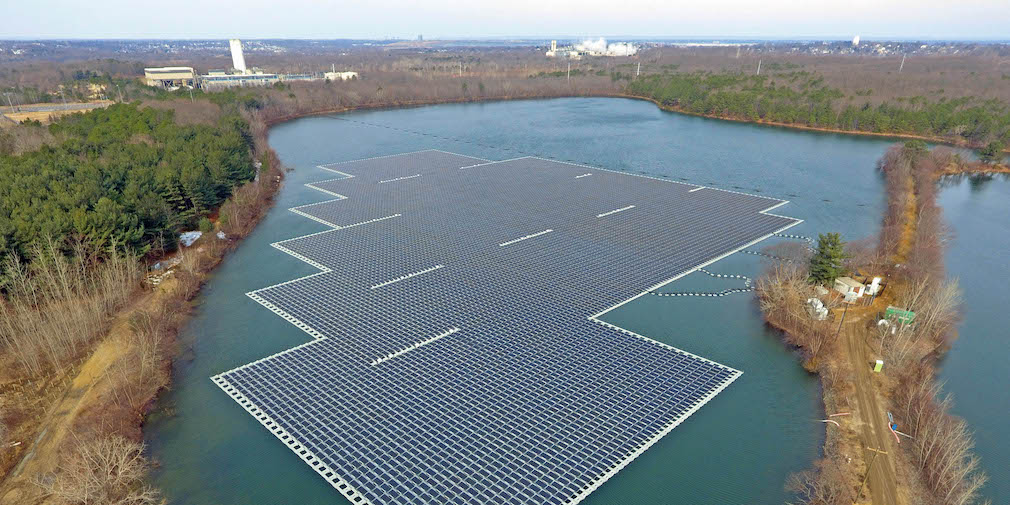NJR Clean Energy Ventures (NJR) announced that it has begun construction on an 8.9 megawatt (MW) floating solar installation in Millburn, New Jersey, just west of NYC, an installation which the company is claiming to be the largest of its kind in the US.
According to the company, NJR will use an innovative floating racking system to install 16,510 solar panels on a reservoir located at the New Jersey American Water Canoe Brook Water Treatment Plant. The clean power generated by the array will provide approximately 95% of the facility’s annual power needs through a power purchase agreement with NJR. The installation has been dubbed the Canoe Brook project and was developed by Solar Renewable Energy LLC, with RETTEW providing engineering, procurement and construction services. NJR acquired the fully permitted and approved project in the first quarter of fiscal 2022. With construction underway, the installation is expected to be fully operational in the fall of 2022.
In addition to generating renewable electricity, the floatovoltaics installation will help to slow evaporation on the reservoir and limit the growth of algae.
“Floating solar technology creates new opportunities for bodies of water to be a home for large-scale renewable energy generation and bring the benefits of clean energy to even more customers,” said Steve Westhoven, president and CEO of New Jersey Resources. “As a leader in New Jersey’s solar marketplace, we look forward to working with New Jersey American Water to support their power needs and advance the state’s clean energy and climate goals.”
The Canoe Brook project is set to be NJR’s second floating solar installation in New Jersey, as well as the second to claim the throne of largest floating solar project in the US. The first was the 4.4. MW floating array in Sayreville, New Jersey. The project, which you can watch a super nifty YouTube video on below, came about in response to a 2015 request for proposals by the city for a solar installation under a power purchase agreement (PPA) to offset power use at a water treatment facility, as well as a handful of other government facilities.
The current claimant to the largest floating solar crown is White Pine Renewables’ 4.8 MW Healdsburg Floating Solar Project, which was installed on ponds at the City of Healdsburg’s wastewater treatment plant. It will deliver energy to the city under under a 25-year power purchase agreement. The solar-generated electricity will cover around 8% of the city’s total energy demand, moving it toward a goal of 60% renewable energy usage before 2030.
Noria Energy co-developed the project with White Pine and provided installation services. The behind-the-meter project’s entire installation, from procurement to commissioning, was completed in less than six months.
Bonus points, this project also has a nifty YouTube overview:
Floating solar has been pegged by the U.S. Department of Energy’s National Renewable Energy Laboratories (NREL) as a “rapidly emerging technology.” A report outlined the technology’s potential to produce just under 10% of current electricity generation.
The technology also offers generally higher energy production, due to the cooling effects of water and wind. Even so, the floating solar has not reached widespread adoption, due in part to higher overall costs than traditional PV plants.
This content is protected by copyright and may not be reused. If you want to cooperate with us and would like to reuse some of our content, please contact: editors@pv-magazine.com.









By submitting this form you agree to pv magazine using your data for the purposes of publishing your comment.
Your personal data will only be disclosed or otherwise transmitted to third parties for the purposes of spam filtering or if this is necessary for technical maintenance of the website. Any other transfer to third parties will not take place unless this is justified on the basis of applicable data protection regulations or if pv magazine is legally obliged to do so.
You may revoke this consent at any time with effect for the future, in which case your personal data will be deleted immediately. Otherwise, your data will be deleted if pv magazine has processed your request or the purpose of data storage is fulfilled.
Further information on data privacy can be found in our Data Protection Policy.